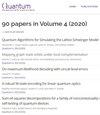可选择的纠缠深度和计量纠缠标准
IF 5.1
2区 物理与天体物理
Q1 PHYSICS, MULTIDISCIPLINARY
引用次数: 0
摘要
我们给出了部分纠缠性质的单参数族的一般理论和由此产生的类纠缠深度量。其中的特殊情况是可分性深度,可生产性深度(或简单的纠缠深度)和可拉伸性深度,它们是基于先前已知的部分纠缠特性的单参数族。我们还进一步构造了一些有物理意义的性质,如可平方性、韧性、自由度,以及几个熵动机性质。具有量子费雪信息的计量多部纠缠准则自然适合于这个框架。在这里,我们将这些公式用于可平方性的深度,因此这被证明是自然的选择,导致比通常的纠缠深度更强的界限。即,对于随机选择基本子系统,量子Fisher信息不仅提供了最大纠缠子系统尺寸的下界,而且提供了纠缠子系统平均尺寸的下界。我们还为这两种情况制定了凸量准则,这比原来的准则强得多。特别是,量子费雪信息给出了纠缠子系统平均大小的下界。我们还认为,带有熵含义的单参数部分纠缠性质更适合于定义计量界。本文章由计算机程序翻译,如有差异,请以英文原文为准。
Alternatives of entanglement depth and metrological entanglement criteria
We work out the general theory of one-parameter families of partial entanglement properties and the resulting entanglement depth-like quantities. Special cases of these are the depth of partitionability, the depth of producibility (or simply entanglement depth) and the depth of stretchability, which are based on one-parameter families of partial entanglement properties known earlier. We also construct some further physically meaningful properties, for instance the squareability, the toughness, the degree of freedom, and also several ones of entropic motivation. Metrological multipartite entanglement criteria with the quantum Fisher information fit naturally into this framework. Here we formulate these for the depth of squareability, which therefore turns out to be the natural choice, leading to stronger bounds than the usual entanglement depth. Namely, the quantum Fisher information turns out to provide a lower bound not only on the maximal size of entangled subsystems, but also on the average size of entangled subsystems for a random choice of elementary subsystems. We also formulate criteria with convex quantities for both cases, which are much stronger than the original ones. In particular, the quantum Fisher information puts a lower bound on the average size of entangled subsystems. We also argue that one-parameter partial entanglement properties, which carry entropic meaning, are more suitable for the purpose of defining metrological bounds.
求助全文
通过发布文献求助,成功后即可免费获取论文全文。
去求助
来源期刊

Quantum
Physics and Astronomy-Physics and Astronomy (miscellaneous)
CiteScore
9.20
自引率
10.90%
发文量
241
审稿时长
16 weeks
期刊介绍:
Quantum is an open-access peer-reviewed journal for quantum science and related fields. Quantum is non-profit and community-run: an effort by researchers and for researchers to make science more open and publishing more transparent and efficient.
 求助内容:
求助内容: 应助结果提醒方式:
应助结果提醒方式:


